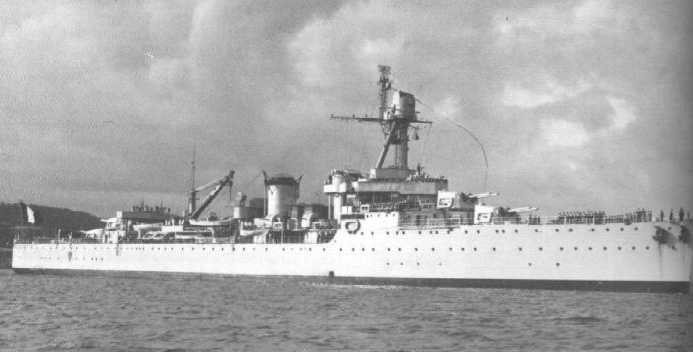Unusual for this size gun in that the twin turrets had the guns individually sleeved. They were also used in single casemate mountings on the carrier Bearn.
Developed from Army guns of the same caliber. Built with an autofretted A tube, liner, jacket in two lengths and breech ring. Used a Welin breech mechanism which opened upwards.
| Designation | 155 mm/50 (6.1") Model 1920 |
|---|---|
| Ship Class Used On | Duguay-Trouin, Jean d'Arc and Bearn classes |
| Date Of Design | 1920 |
| Date In Service | 1926 |
| Gun Weight | 8.73 tons (8.87 mt) |
| Gun Length oa | 316.9 in (8.050 m) |
| Bore Length | 305.1 in (7.750 m) |
| Rifling Length | 250.5 in (6.362 m) |
| Grooves | (about 46) about 0.059 in deep x 0.295 in (1.5 mm x 7.5 mm) |
| Lands | about 0.120 in (3 mm) |
| Twist | Uniform RH 1 in 22.35 |
| Chamber Volume | 2,238 in3 (36.67 dm3) |
| Rate Of Fire | 3-5 rounds per minute 1 |
- ^The expected rate of fire for the light cruisers was six rounds per minute, but three rounds per minute was the usual rate of fire. The Permanent Trials Board criticized the complicated ammunition supply system.
| Type | Bag |
|---|---|
| Projectile Types and Weights | SAPBC M1924(?) 1a - 124.6 lbs. (56.5 kg)
HE M19??, internal nose fuze 2a - 130.1 lbs. (59.0 kg) HE M19??, base fuze (original) - 124.6 lbs. (56.5 kg) HE M19??, base fuze (later) - 124.6 lbs. (56.5 kg) Starshell M19?? - N/A Illum - N/A |
| Bursting Charge | SAPBC M1924 - 7.3 lbs. (3.3 kg)
HE M19??, internal nose fuze - 12.4 lbs. (5.6 kg) Mélinite HE M19??, base fuze (original) - about 7.4 lbs. (3.3 kg) Mélinite HE M19??, base fuze (later) - about 6.5 lbs (2.9 kg) cast TNT |
| Projectile Length | SAPBC M1924 - 31.5 in (80 cm)
HE (all) - about 30.5 in (77.5 cm) |
| Propellant Charge | 43.67 lbs. (19.81 kg) BM11 3a |
| Muzzle Velocity | New gun with SAPBC M1924 - 2,854 fps (870 mps)
New gun with HE, base fuze - 2,835 fps (864 mps) Average gun - 2,789 fps (850 mps) |
| Working Pressure | about 19.4 tons/in2 (3,050 kg/cm2) |
| Approximate Barrel Life | about 700 rounds |
| Ammunition stowage per gun | Duguay-Trouin - 125 rounds 4a Jean d'Arc - 150 rounds Bearn - N/A |
- ^A Note on Sources: "Naval Weapons of World War Two" calls this projectile a "SAP" shell but the actual French designation was "OPf" (Obus Perforant – literally 'Piercing Shell'). This implies a separate AP cap fixed to the upper part of the shell body. Sketches of this projectile (see below) show a conical shape under the ballistic cap which is generally interpreted as indicating a hardened shell cap. The details of this sketch are similar to those for the 203 mm/50 M1924 SAPBC. The burster weight for this shell is about 5.9% of the total shell weight, which is high for an APC-type but low for a SAP-type. For these reasons, I believe that the 155 mm projectile is more properly called an "SAPBC" type. The actual Model year for this projectile is not known. M1924 is the estimate given in "French Cruisers 1922 - 1956."
- ^The Model date for all HE shell types is unknown.
- ^The propellant charge was in halves.
- ^The outfit on Duguay-Trouin was 1,000 HE, 60 illumination for upper turrets, no illumination for lower turrets, 40 practice rounds for upper turrets and 120 practice rounds for lower turrets.
| Elevation | 124.6 lbs. (56.5 kg) SAPBC Shell | 124.6 lbs. (56.5 kg) HE Shell |
|---|---|---|
| 5 degrees | 9,400 yards (8,600 m) | --- |
| 10 degrees | 14,220 yards (13,000 m) | --- |
| 30 degrees | 24,060 yards (22,000 m) | --- |
| 40 degrees | 27,340 yards (25,000 m) | 28,543 yards (26,100 m) |
| Designation | Single Mounts
Bearn (8): N/A Two-gun Turrets
|
|---|---|
| Weight | Single Mount: N/A
Twin Mount: about 78.7 tons (80 mt) |
| Elevation | -5 / +40 degrees |
| Elevation Rate | about 6 degrees per second |
| Train | Model 1921: -140 / +140 degrees
Others: N/A |
| Train Rate | 6.4 degrees per second |
| Gun recoil | Nominal: 19.7 in (50 cm)
Maximum: 21.7 in (55 cm) |
- ^The turrets on Jean d'Arc were larger and roomier so as to fit her role as a training ship.
- Training and elevation for the two-gun turrets were electrically powered. The design of these were basically scaled-down versions of the earlier twin battleship turrets with twin dredger cage hoists running from the magazine and ammunition spaces up to a rotating working chamber. From here the ammunition was transferred into upper cage hoists which came up on the outside of each gun. Shells and charges were then manually transferred to loading trays and rammed by power. RPC for training was slated to be added to these but cancelled upon France's surrender in 1940. The gunhouses were gas tight with forced ventilation. "French Cruisers: 1922 - 1956" says that the guns proved unreliable and experienced "regular breakdowns" throughout their service lives.
- The gun axes were 59 in (150 cm) apart.
- Twin turrets had 0.98 in (2.5 cm) armor. Shield on single mounts was 2.76 in (7.0 cm).

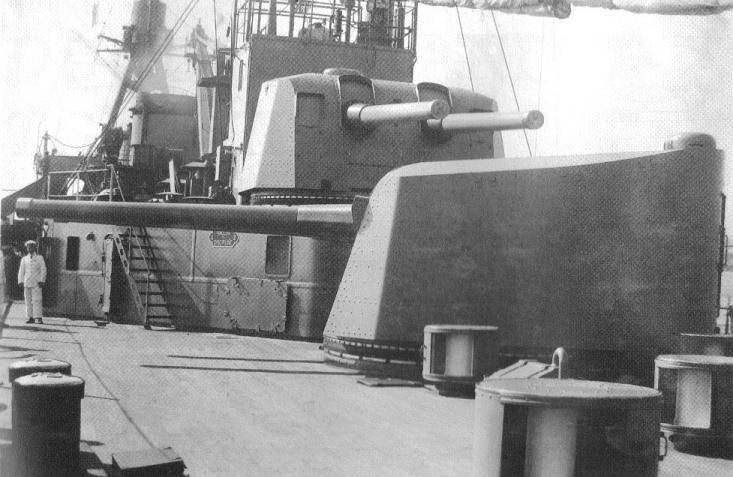
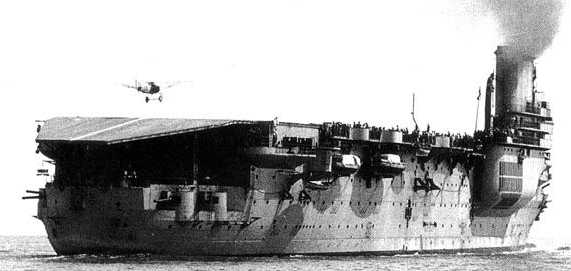
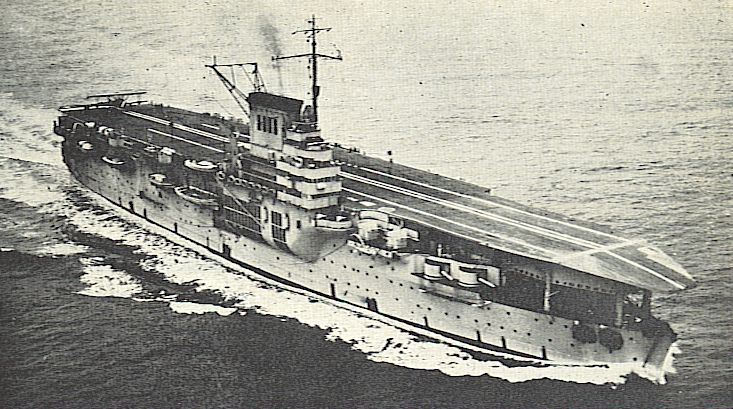
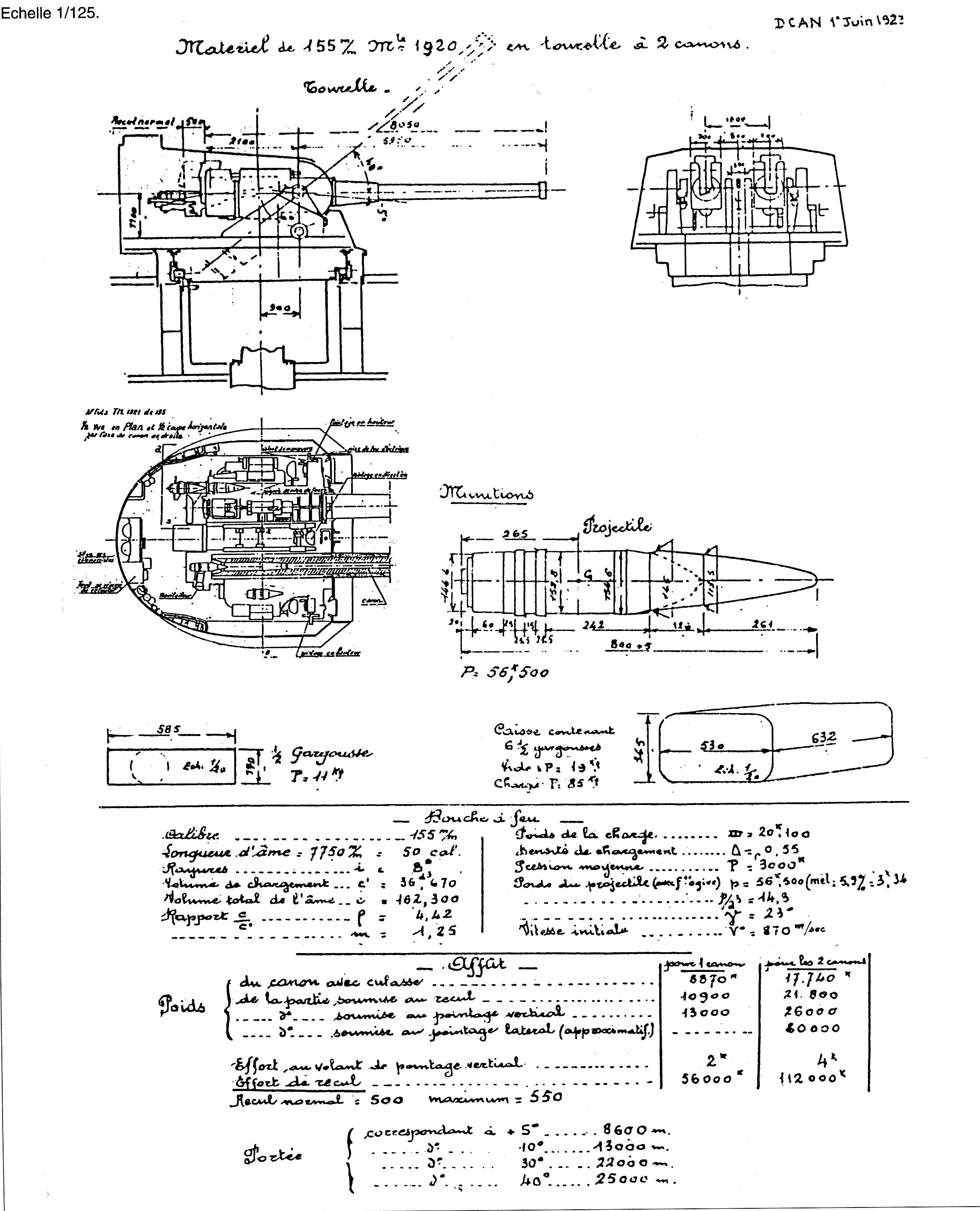
"Naval Weapons of World War Two" by John Campbell
"French Light Cruisers" article in Warships International No. 3, 2001, by Jean Guigliani and Albert Moreau
"French Cruisers: 1922 - 1956" by John Jordan and Jean Moulin
"Navies of the Second World War - The French Navy" by Henri le Masson
"Cruisers of World War Two" by M.J. Whitley
---
Special help by John Jordan
24 March 2007 - Benchmark
14 August 2010 - Added additional projectile weights and burster weights
28 March 2012 - Updated to latest template
29 March 2013 - Added information about twin turret mountings
05 April 2020 - Updated to HTML 5 format
14 February 2022 - Added ammunition details
13 May 2023 - Added details on SAPBC projectile and Mounting/Projectile sketch

